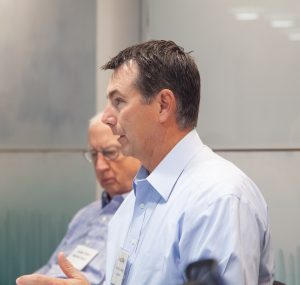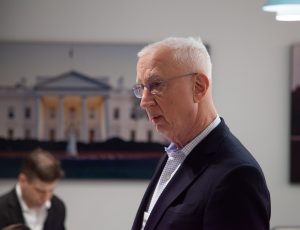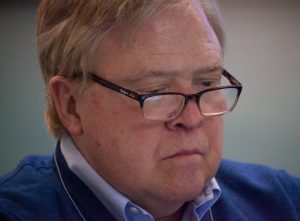IPWatchdog’s most recent Patent Masters™ Symposium, held Monday and Tuesday March 25-26 in Washington, D.C., examined the state of the U.S. patent system and how we arrived here. Some concluded that Congress, rather than the courts, must take action to resolve the many conflicts that presently exist in the muddled judicial approach to patents that has developed over the last two decades or the U.S. patent system will become irrelevant.
U.S. Innovators: Closing Shop

Russell Slifer, Former Deputy Director of the USPTO
While the mainstream narrative traditionally has held that patents impede innovation by making access to technology too difficult or expensive, the narrative that unfolded over the two days of discussions with some of the leading legal experts in the field told quite an opposite tale. Institutions such as the Cleveland Clinic are closing up their diagnostics shops due to uncertainty around Section 101 law in that area, and small businesses are unable to secure funding due to the many risks and expenses surrounding patent enforcement in a post-America Invents Act environment. These developments demonstrate that patents are vital to economic prosperity and that weak patents result in medical and other technologies simply not being made here. Many of the Masters lamented the fact that China and Europe currently have more reliable patent systems than the United States, precisely because those countries have begun to copy the previous U.S. approach, while we stray farther away from it. Alden Abbott, General Counsel of the U.S. Federal Trade Commission, delivered a keynote speech in which he emphasized that uncertainty around the ability to obtain patents is also harming the U.S. competitive process.
The Right Solution

Paul Michel, Former Chief Judge, Federal Circuit
Beginning with eBay, patents have become markedly and progressively weaker. While a major reason for this has been the Supreme Court’s often too broad, misguided or misinformed opinions, some Masters felt the Federal Circuit, as the court responsible for streamlining and developing IP law, was more to blame. Others said that—as the CAFC has itself stated in recent opinions—the Federal Circuit is simply stuck with what the Supreme Court has done and is sick of being overruled, and thus Congress is the only viable alternative to remedy the problems.
One of the Masters, former Federal Circuit Chief Judge Paul Michel, went on record with IPWatchdog to say that Congress must be the vehicle for effectively fixing the patent system:
As imperfect or even dysfunctional, in the view of some, as the Congress might seem, it is the right branch of the government to be making these hugely important national decisions that are going to decide job creation, global competitiveness, national security, economic growth, and productivity growth. Even if they make decisions I might disagree with, it’s still better for the decisions to be made by the duly elected representatives of the citizenry, not by black robed lawyers at any level, including the Supreme Court. I’m of the view that Congress can learn what it needs to learn, as it does all the time, to make rational, logical decisions on behalf of the country and, unlike the courts, if it works badly in practice they can come back and change it. The Supreme Court is focused on precedents, so once set it’s very hard to ever get around them. When Congress initiates a new law, it only applies in the future; when the Supreme Court or Federal Circuit decides a case, they’re often deciding that something done 10 or 20 years ago now has to be invalidated. The retroactive reach of judicial decisions is hugely problematic in our society.
Glimmers of Hope
Much of the two days was spent discussing solutions on the horizon, such as the various legislative proposals that could be introduced this term. These include the STRONGER Patents Act, which would address almost all of the major sticking points, from locking in the Phillips standard for claim construction to changing the burden of proof at the PTAB, reducing repetitive IPR attacks on the same patents, and restoring the presumption of injunctive relief. Prospects for movement on this bill and separate reform to Section 101 law are thought to be generally good, since the Senate IP Subcommittee includes some very patent-savvy players who seem genuinely interested in resolving these issues—many as the result of their constituents directly expressing concerns to them.
In closed-door meetings on the Hill about Section 101 issues, the following principles have been agreed upon by those seeking to propose legislation:
Guiding Principles for Section 101 Reform
- Patent eligibility should not turn on the existence of related technology or the current state of the art. In other words, subject to meeting all other requirements of the patent statute, especially novelty, obviousness, enablement, written description, and definiteness, any useful invention should be eligible for protection regardless of whether it is new or old, conventional, known, or using other terms relevant to determining obviousness or anticipation.
- When assessing the eligibility of patent claims, those claims must be construed as a whole, with each limitation in a claim given equal weight, and none dismissed or discounted as “routine,” “known,” “conventional,” mere “data gathering,” mere “post-solution activity,” or the like. It is impermissible to carve up a claim into different parts and assess the eligibility of the parts of a claim separately, rather eligibility must consider the claimed invention as a whole.
- Diagnostic and life science technologies should be eligible for patent protection per se, subject to meeting the other existing statutory requirements, and should not be considered a law of nature, natural phenomena, or otherwise patent ineligible subject matter.
- Any reform to Section 101 should statutorily codify a definition and/or exception(s) to patent eligibility. Any statutory exception(s) should not use the existing judicial exceptions of abstract ideas, laws of nature, or natural phenomena. Any statutory exceptions should be the sole and exclusive basis for excluding subject matter from eligibility and may not be expanded upon by courts. Any definition of eligible subject matter should be adaptive to include new technologies not yet invented.

Todd Dickinson, Former USPTO Director
Other possible fixes—or further damage—could come in the form of cert being granted in Berkheimer, Vanda, or Athena Diagnostics. While Berkheimer and Vanda are awaiting input from the U.S. Solicitor General at the invitation of the Court, Athena Diagnostics has not yet filed a petition for certiorari but is expected to. Many at the Patent Masters Symposium were fearful that the Supreme Court taking these cases up would only do further damage on eligibility law.
If Congress does pursue patent reform, the patent bar will have a key role to play in ensuring that inventors’ stories and the real-world effects of weak patents get told. With the AIA, big tech was able to swing the pendulum toward reforms that worked best for them thanks to massive lobbying efforts and PR campaigns, but the tide could be turning, as increased scrutiny has been placed on them over privacy concerns, and as more companies become vocal about the harmful effects of being unable to rely on patent rights.
In the words of one Master: “We’re in the ditch, but optimistic about the future—but I think we need to realize it will only get better if we make our voices heard.”
IPWatchdog’s next Patent Masters™ Symposium will take place June 24-25 and will focus on the status of patent eligibility five years after Alice. Discussion topics will include possible legislative reforms, impact on the economy, uncertainty in the application of irreconcilable Supreme Court decisions, and how one can attempt to protect computer implemented innovations in uncertain times.

![[IPWatchdog Logo]](https://ipwatchdog.com/wp-content/themes/IPWatchdog%20-%202023/assets/images/temp/logo-small@2x.png)

![[Advertisement]](https://ipwatchdog.com/wp-content/uploads/2024/04/UnitedLex-May-2-2024-sidebar-700x500-1.jpg)
![[Advertisement]](https://ipwatchdog.com/wp-content/uploads/2024/04/Artificial-Intelligence-2024-REPLAY-sidebar-700x500-corrected.jpg)
![[Advertisement]](https://ipwatchdog.com/wp-content/uploads/2024/04/Patent-Litigation-Masters-2024-sidebar-700x500-1.jpg)

![[Advertisement]](https://ipwatchdog.com/wp-content/uploads/2021/12/WEBINAR-336-x-280-px.png)
![[Advertisement]](https://ipwatchdog.com/wp-content/uploads/2021/12/2021-Patent-Practice-on-Demand-recorded-Feb-2021-336-x-280.jpg)
![[Advertisement]](https://ipwatchdog.com/wp-content/uploads/2021/12/Ad-4-The-Invent-Patent-System™.png)






Join the Discussion
7 comments so far.
angry dude
March 28, 2019 09:16 amNothing major is going to happen until China eats US high-tech and other industries alive and lemmings run out of their popcorn
Anon
March 28, 2019 07:53 am“Many of the Masters lamented the fact that China and Europe currently have more reliable patent systems than the United States, precisely because those countries have begun to copy the previous U.S. approach”
What utter nonsense! China and Europe have more reliable patent systems because they have AVOIDED the US approach!
Concerned
March 28, 2019 06:42 amAnon:
The person who drafted the Alice claims told the USPTO in its comments on the new guidance that any solution should be codified by Congress, then get rid of SCOTUS in the patent venue.
Whether have I heard this drum beat before? LOL.
Benny
March 28, 2019 05:16 am“weak patents result in medical and other technologies simply not being made here.”
Makes no sense at all. If your market is the EU, you patent in the EU. If your competitor is in the EU, you chase the importer, who rarely has the funds or inclination to enter into litigation or invalidation. If your competitor is in the US – they share the same problems, their patents are as weak or strong as yours, levelling the playing field.
“China and Europe currently have more reliable patent systems than the United States”
The EPO is far more professional than the USPTO when it comes to examination, but they are still a long way from perfect. That said, if I wanted to invalidate a granted patent, I’d have an easier time in Europe than the US. The procedures would be faster, cheaper and more professional, and if I present a valid case for why a patent should be revoked, that patent would be short-lived.
Y’all want the EPO post-grant review system in the US? Be careful what you wish for.
Night Writer
March 28, 2019 04:39 am@1 Mike >> a patent bargain in which the inventor never agreed, and a direct violation of the Constitution’s 5th amendment Takings
This will go to the SCOTUS. My guess is that the SCOTUS will simply water down more public rights and say it is fine to do.
Mike
March 28, 2019 12:02 amTC Heartland was just as detrimental to inventors as was Alice. Because of TC Heartland, the pendulum swung way too far in favor of infringers because inventors now must travel all over the United States to stop infringers from profiting from their inventions, which discourages innovation because small independent inventors cannot feasibly defend their patent rights.
The VENUE Act (S.2733 of 114th Congress), particularly 1400(b)(4) which expanded venue to include the place of the inventor’s research or development, solved this problem.
In addition to where the defendent has an established place of business or where the defendant committed infringement, the VENUE Act also allows this as a venue:
“WHERE AN INVENTOR named on the patent in suit conducted research or development that led to the application for the patent in suit”.
Note that because venue is expanded in a limited fashion only for named inventors listed on the face of patents, this does not introduce forum shopping — this simply helps inventors.
Congress needs to include this venue amendment in 1400(b).
For the full text of S.2733, see https://www.congress.gov/bill/114th-congress/senate-bill/2733/text
Mike
March 27, 2019 11:45 pmChief Judge Paul Michel going on record with “When Congress initiates a new law, it only applies in the future;” is FALSE. As Jeff mentioned here
— https://ipwatchdog.com/2019/03/20/cta-preaches-patent-troll-fairy-tale-chat-iancu-sxsw/id=107539/ —
when he stood up during thr Q&A during the fireside chat with Iancu at SxSW, the AIA was “new law” and it was retroactively applied. The AIA established that an IPR can be instituted on a patent having a preAIA priority date — a patent bargain in which the inventor never agreed, and a direct violation of the Constitution’s 5th amendment Takings, Due Process, and Ex Post Facto clauses. I’ve been saying this over and over since the Oil States ruling.